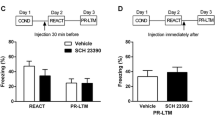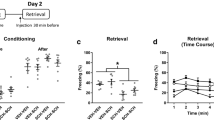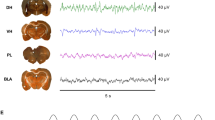Abstract
Dopamine seems to mediate fear conditioning through its action on D2 receptors in the mesolimbic pathway. Systemic and local injections of dopaminergic agents showed that D2 receptors are preferentially involved in the expression, rather than in the acquisition, of conditioned fear. To further examine this issue, we evaluated the effects of systemic administration of the dopamine D2-like receptor antagonists sulpiride and haloperidol on the expression and extinction of contextual and cued conditioned fear in rats. Rats were trained to a context-CS or a light-CS using footshocks as unconditioned stimuli. After 24 h, rats received injections of sulpiride or haloperidol and were exposed to the context-CS or light-CS for evaluation of freezing expression (test session). After another 24 h, rats were re-exposed to the context-CS or light-CS, to evaluate the extinction recall (retest session). Motor performance was assessed with the open-field and catalepsy tests. Sulpiride, but not haloperidol, significantly reduced the expression of contextual and cued conditioned fear without affecting extinction recall. In contrast, haloperidol, but not sulpiride, had cataleptic and motor-impairing effects. The results reinforce the importance of D2 receptors in fear conditioning and suggest that dopaminergic mechanisms mediated by D2 receptors are mainly involved in the expression rather than in the extinction of conditioned freezing.



Similar content being viewed by others
Data availability statement
The datasets generated during and/or analysed during the current study are available from the corresponding author on reasonable request.
References
Abraham AD, Neve KA, Lattal KM (2014) Dopamine and extinction: a convergence of theory with fear and reward circuitry. Neurobiol Learn Mem 108:65–77
Adams CE, Bergman H, Irving CB, Lawrie S (2013) Haloperidol versus placebo for schizophrenia. Cochrane Database Syst Rev 11:CD003082
Albrechet-Souza L, Borelli KG, Almada RC, Brandão ML (2011) Midazolam reduces the selective activation of the rhinal cortex by contextual fear stimuli. Behav Brain Res 216:631–638
Albrechet-Souza L, Carvalho MC, Brandão ML (2013) D(1)-like receptors in the nucleus accumbens shell regulate the expression of contextual fear conditioning and activity of the anterior cingulate cortex in rats. Int J Neuropsychopharmacol 16:1045–1057
Arnt J (1982) Pharmacological specificity of conditioned avoidance response inhibition in rats: inhibition by neuroleptics and correlation to dopamine receptor blockade. Acta Pharmacol Toxicol 51:321–329
Barroca NCB, Guarda MD, da Silva NT, Colombo AC, Reimer AE, Brandão ML, de Oliveira AR (2019) Influence of aversive stimulation on haloperidol-induced catalepsy in rats. Behav Pharmacol 30:229–238
Blanchard RJ, Blanchard DC (1972a) Effects of hippocampal lesions on the rat’s reaction to a cat. J Comp Physiol Psychol 78:77–82
Blanchard DC, Blanchard RJ (1972b) Innate and conditioned reactions to threat in rats with amygdaloid lesions. J Comp Physiol 81:281–290
Bolles RC, Collier AC (1976) The effect of predictive cues on freezing in rats. Anim Learn Behav 4:6–8
Borowski TB, Kokkinidis L (1996) Contribution of ventral tegmental area dopamine neurons to expression of conditional fear: effects of electrical stimulation, excitotoxin lesions, and quinpirole infusion on potentiated startle in rats. Behav Neurosci 110:1349–1364
Brandão ML, Coimbra NC (2018) Understanding the role of dopamine in conditioned and unconditioned fear. Rev Neurosci 30:325–337
Brandão ML, de Oliveira AR, Muthuraju S, Colombo AC, Saito VM, Talbot T (2015) Dual role of dopamine D2-like receptors in the mediation of conditioned and unconditioned fear. FEBS Lett 589:3433–3437
Burgdorf J, Panksepp J (2006) The neurobiology of positive emotions. Neurosci Biobehav Rev 30:173–187
Carrive P (2000) Conditioned fear to environmental context: cardiovascular and behavioral components in the rat. Brain Res 858:440–445
Carvalho MC, Albrechet-Souza L, Masson S, Brandão ML (2005) Changes in the biogenic amine content of the prefrontal cortex, amygdala, dorsal hippocampus, and nucleus accumbens of rats submitted to single and repeated sessions of the elevated plus-maze test. Braz J Med Biol Res 38:1857–1866
Carvalho JD, de Oliveira AR, da Silva RC, Brandão ML (2009) A comparative study on the effects of the benzodiazepine midazolam and the dopamine agents, apomorphine and sulpiride, on rat behavior in the two-way avoidance test. Pharmacol Biochem Behav 92:351–356
Colombo AC, de Oliveira AR, Reimer AE, Brandão ML (2013) Dopaminergic mechanisms underlying catalepsy, fear and anxiety: do they interact? Behav Brain Res 257:201–207
Creese I, Burt DR, Snyder SH (1976) Dopamine receptor binding predicts clinical and pharmacological potencies of antischizophrenic drugs. Science 192:481–483
Cuadra G, Zurita A, Macedo CE, Molina VA, Brandão ML (2000) Electrical stimulation of the midbrain tectum enhances dopamine release in the frontal cortex. Brain Res Bull 52:413–418
Datla KP, Ahier RG, Young AM, Gray JA, Joseph MH (2002) Conditioned appetitive stimulus increases extracellular dopamine in the nucleus accumbens of the rat. Eur J Neurosci 16:1987–1993
Davis M (1990) Animal models of anxiety based on classical conditioning: the conditioned emotional response (CER) and the fear-potentiated startle effect. Pharmacol Ther 47:147–165
de Oliveira AR, Reimer AE, Brandão ML (2006) Dopamine D2 receptor mechanisms in the expression of conditioned fear. Pharmacol Biochem Behav 84:102–111
de Oliveira AR, Reimer AE, Brandão ML (2009) Role of dopamine receptors in the ventral tegmental area in conditioned fear. Behav Brain Res 199:271–277
de Oliveira AR, Reimer AE, de Macedo CE, de Carvalho MC, Silva MA, Brandão ML (2011) Conditioned fear is modulated by D2 receptor pathway connecting the ventral tegmental area and basolateral amygdala. Neurobiol Learn Mem 95:37–45
de Oliveira AR, Reimer AE, Reis FM, Brandão ML (2013) Conditioned fear response is modulated by a combined action of the hypothalamic-pituitary-adrenal axis and dopamine activity in the basolateral amygdala. Eur Neuropsychopharmacol 23:379–389
de Oliveira AR, Colombo AC, Muthuraju S, Almada RC, Brandão ML (2014a) Dopamine d2-like receptors modulate unconditioned fear: role of the inferior colliculus. PLoS ONE 9:e104228
de Oliveira AR, Reimer AE, Brandão ML (2014b) Mineralocorticoid receptors in the ventral tegmental area regulate dopamine efflux in the basolateral amygdala during the expression of conditioned fear. Psychoneuroendocrinology 43:114–125
de Oliveira AR, Reimer AE, Reis FM, Brandão ML (2017) Dopamine D2-like receptors modulate freezing response, but not the activation of HPA axis, during the expression of conditioned fear. Exp Brain Res 235:429–436
de Ryck M, Schallert T, Teitelbaum P (1980) Morphine versus haloperidol catalepsy in the rat: a behavioral analysis of postural support mechanisms. Brain Res 201:143–172
de Souza Caetano KA, de Oliveira AR, Brandão ML (2013) Dopamine D2 receptors modulate the expression of contextual conditioned fear: role of the ventral tegmental area and the basolateral amygdala. Behav Pharmacol 24:264–274
Deutch AY, Tam SY, Roth RH (1985) Footshock and conditioned stress increase 3,4-dihydroxyphenylacetic acid (DOPAC) in the ventral tegmental area but not substantia nigra. Brain Res 333:143–146
Di Lorenzo R, Ferri P, Cameli M, Rovesti S, Piemonte C (2019) Effectiveness of 1-year treatment with long-acting formulation of aripiprazole, haloperidol, or paliperidone in patients with schizophrenia: retrospective study in a real-world clinical setting. Neuropsychiatr Dis Treat 15:183–198
Fadok JP, Dickerson TM, Palmiter RD (2009) Dopamine is necessary for cue-dependent fear conditioning. J Neurosci 29:11089–11097
Fadok JP, Darvas M, Dickerson TM, Palmiter RD (2010) Long-term memory for pavlovian fear conditioning requires dopamine in the nucleus accumbens and basolateral amygdala. PLoS ONE 5:e12751
Feenstra MG, Botterblom MH, van Uum JF (1995) Novelty-induced increase in dopamine release in the rat prefrontal cortex in vivo: inhibition by diazepam. Neurosci Lett 189:81–84
Fendt M, Fanselow MS (1999) The neuroanatomical and neurochemical basis of conditioned fear. Neurosci Biobehav Rev 23:743–760
Goldstein LE, Rasmusson AM, Bunney BS, Roth RH (1996) Role of the amygdala in the coordination of behavioral, neuroendocrine, and prefrontal cortical monoamine responses to psychological stress in the rat. J Neurosci 16:4787–4798
Grillon C (2002) Associative learning deficits increase symptoms of anxiety in humans. Biol Psychiat 51:851–858
Guarraci FA, Kapp BS (1999) An electrophysiological characterization of ventral tegmental area dopaminergic neurons during differential pavlovian fear conditioning in the awake rabbit. Behav Brain Res 99:169–179
Hitchcock JM, Davis M (1987) Fear-potentiated startle using an auditory conditioned stimulus: effect of lesions of the amygdala. Physiol Behav 39:403–408
Indovina I, Robbins TW, Nunez-Elizalde AO, Dunn BD, Bishop SJ (2011) Fear-conditioning mechanisms associated with trait vulnerability to anxiety in humans. Neuron 69:563–571
Kalisch R, Gerlicher AMV, Duvarci S (2019) A dopaminergic basis for fear extinction. Trends Cogn Sci 23:274–277
Kim JJ, Fanselow MS (1992) Modality-specific retrograde amnesia of fear. Science 256:675–677
LeDoux JE (2014) Coming to terms with fear. Proc Natl Acad Sci USA 111:2871–2878
Lloyd K, Dayan P (2016) Safety out of control: dopamine and defence. Behav Brain Funct 12:15
Lonsdorf TB, Merz CJ, Fullana MA (2019) Fear extinction retention: is it what we think it is? Biol Psychiat 85:1074–1082
Lorenc-Koci E, Wolfarth S, Ossowska K (1996) Haloperidol-increased muscle tone in rats as a model of parkinsonian rigidity. Exp Brain Res 109:268–276
Luo R, Uematsu A, Weitemier A, Aquili L, Koivumaa J, McHugh TJ, Johansen JP (2018) A dopaminergic switch for fear to safety transitions. Nat Commun 9:2483
Macedo CE, Cuadra G, Molina V, Brandão ML (2005) Aversive stimulation of the inferior colliculus changes dopamine and serotonin extracellular levels in the frontal cortex: modulation by the basolateral nucleus of amygdala. Synapse 55:58–66
Madsen HB, Guerin AA, Kim JH (2017) Investigating the role of dopamine receptor- and parvalbumin-expressing cells in extinction of conditioned fear. Neurobiol Learn Mem 145:7–17
Martinez RC, Oliveira AR, Macedo CE, Molina VA, Brandão ML (2008) Involvement of dopaminergic mechanisms in the nucleus accumbens core and shell subregions in the expression of fear conditioning. Neurosci Lett 446:112–116
Milad MR, Quirk GJ (2012) Fear extinction as a model for translational neuroscience: ten years of progress. Annu Rev Psychol 63:129–151
Milad MR, Quinn BT, Pitman RK, Orr SP, Fischl B, Rauch SL (2005) Thickness of ventromedial prefrontal cortex in humans is correlated with extinction memory. Proc Natl Acad Sci USA 102:10706–10711
Milad MR, Pitman RK, Ellis CB, Gold AL, Shin LM, Lasko NB, Zeidan MA, Handwerger K, Orr SP, Rauch SL (2009) Neurobiological basis of failure to recall extinction memory in posttraumatic stress disorder. Biol Psychiat 66:1075–1082
Milad MR, Furtak SC, Greenberg JL, Keshaviah A, Im JJ, Falkenstein MJ, Jenike M, Rauch SL, Wilhelm S (2013) Deficits in conditioned fear extinction in obsessive-compulsive disorder and neurobiological changes in the fear circuit. JAMA Psychiat 70:608–618
Miller RE, Murphy JV, Mirsky IA (1957) The effect of chlorpromazine on fear-motivated behavior in rats. J Pharmacol Exp Ther 120:379–387
Mobbs D, Marchant JL, Hassabis D, Seymour B, Tan G, Gray M, Petrovic P, Dolan RJ, Frith CD (2009) From threat to fear: the neural organization of defensive fear systems in humans. J Neurosci 29:12236–12243
Munro LJ, Kokkinidis L (1997) Infusion of quinpirole and muscimol into the ventral tegmental area inhibits fear-potentiated startle: implications for the role of dopamine in fear expression. Brain Res 746:231–238
Nader K, LeDoux J (1999a) The dopaminergic modulation of fear: quinpirole impairs the recall of emotional memories in rats. Behav Neurosci 113:152–165
Nader K, LeDoux JE (1999b) Inhibition of the mesoamygdala dopaminergic pathway impairs the retrieval of conditioned fear associations. Behav Neurosci 113:891–901
Oades RD, Halliday GM (1987) Ventral tegmental (A10) system: neurobiology. 1. Anatomy and connectivity. Brain Res 434:117–165
Ohman A, Mineka S (2001) Fears, phobias, and preparedness: toward an evolved module of fear and fear learning. Psychol Rev 108:483–522
Pavlov IP (1927) Conditioned reflexes: an investigation of the physiological activity of the cerebral cortex. Oxford Univ. Press, Oxford
Pezze MA, Feldon J (2004) Mesolimbic dopaminergic pathways in fear conditioning. Prog Neurobiol 74:301–320
Phelps EA, LeDoux JE (2005) Contributions of the amygdala to emotion processing: from animal models to human behavior. Neuron 48:175–187
Phillips RG, LeDoux JE (1992) Differential contribution of amygdala and hippocampus to cued and contextual fear conditioning. Behav Neurosci 106:274–285
Ponnusamy R, Nissim HA, Barad M (2005) Systemic blockade of D2-like dopamine receptors facilitates extinction of conditioned fear in mice. Learn Mem 12:399–406
Posluns D (1962) An analysis of chlorpromazine-induced suppression of the avoidance response. Psychopharmacologia 3:361–373
Reimer AE, de Oliveira AR, Brandão ML (2012) Glutamatergic mechanisms of the dorsal periaqueductal gray matter modulate the expression of conditioned freezing and fear-potentiated startle. Neuroscience 219:72–81
Reimer AE, de Oliveira AR, Diniz JB, Hoexter MQ, Chiavegatto S, Brandão ML (2015) Rats with differential self-grooming expression in the elevated plus-maze do not differ in anxiety-related behaviors. Behav Brain Res 292:370–380
Reimer AE, de Oliveira AR, Diniz JB, Hoexter MQ, Miguel EC, Milad MR, Brandão ML (2018) Fear extinction in an obsessive-compulsive disorder animal model: influence of sex and estrous cycle. Neuropharmacology 131:104–115
Reis FL, Masson S, de Oliveira AR, Brandão ML (2004) Dopaminergic mechanisms in the conditioned and unconditioned fear as assessed by the two-way avoidance and light switch-off tests. Pharmacol Biochem Behav 79:359–365
Reynolds GP (1992) Developments in the drug treatment of schizophrenia. Trends Pharmacol Sci 13:116–121
Sanberg PR (1980) Haloperidol-induced catalepsy is mediated by postsynaptic dopamine receptors. Nature 284:472–473
Schoemaker H, Claustre Y, Fage D, Rouquier L, Chergui K, Curet O, Oblin A, Gonon F, Carter C, Benavides J, Scatton B (1997) Neurochemical characteristics of amisulpride, an atypical dopamine D2/D3 receptor antagonist with both presynaptic and limbic selectivity. J Pharmacol Exp Ther 280:83–97
Schultz W (2015) Neuronal reward and decision signals: from theories to data. Physiol Rev 95:853–951
Shi YW, Fan BF, Xue L, Wen JL, Zhao H (2017) Regulation of fear extinction in the basolateral amygdala by dopamine D2 receptors accompanied by altered GluR1, GluR1-Ser845 and NR2B levels. Front Behav Neurosci 11:116
Tran PV, Dellva MA, Tollefson GD, Beasley CM Jr, Potvin JH, Kiesler GM (1997) Extrapyramidal symptoms and tolerability of olanzapine versus haloperidol in the acute treatment of schizophrenia. J Clin Psychiatry 58:205–211
Vasconcelos SM, Nascimento VS, Nogueira CR, Vieira CM, Sousa FC, Fonteles MM, Viana GS (2003) Effects of haloperidol on rat behavior and density of dopaminergic D2-like receptors. Behav Proc 63:45–52
Wadenberg ML (2010) Conditioned avoidance response in the development of new antipsychotics. Curr Pharm Des 16:358–370
Wadenberg ML, Hicks PB (1999) The conditioned avoidance response test re-evaluated: is it a sensitive test for the detection of potentially atypical antipsychotics? Neurosci Biobehav Rev 23:851–862
Wadenberg ML, Soliman A, VanderSpek SC, Kapur S (2001) Dopamine D(2) receptor occupancy is a common mechanism underlying animal models of antipsychotics and their clinical effects. Neuropsychopharmacology 25:633–641
Zweifel LS, Fadok JP, Argilli E, Garelick MG, Jones GL, Dickerson TM, Allen JM, Mizumori SJ, Bonci A, Palmiter RD (2011) Activation of dopamine neurons is critical for aversive conditioning and prevention of generalized anxiety. Nat Neurosci 14:620–626
Acknowledgements
This study was supported by the São Paulo Research Foundation (FAPESP—Proc. No. 2016/04620-1), the Brazilian National Council for Scientific and Technological Development (CNPq—Proc. No. 401032/2016-7), and Coordenação de Aperfeiçoamento de Pessoal de Nível Superior (CAPES—Finance Code 001).
Author information
Authors and Affiliations
Corresponding author
Ethics declarations
Conflict of interest
On behalf of all authors, the corresponding author states that there is no conflict of interest.
Additional information
Communicated by Thomas Deller.
Publisher's Note
Springer Nature remains neutral with regard to jurisdictional claims in published maps and institutional affiliations.
Supplementary Information
Below is the link to the electronic supplementary material.
Rights and permissions
About this article
Cite this article
de Vita, V.M., Zapparoli, H.R., Reimer, A.E. et al. Dopamine D2 receptors in the expression and extinction of contextual and cued conditioned fear in rats. Exp Brain Res 239, 1963–1974 (2021). https://doi.org/10.1007/s00221-021-06116-6
Received:
Accepted:
Published:
Issue Date:
DOI: https://doi.org/10.1007/s00221-021-06116-6




